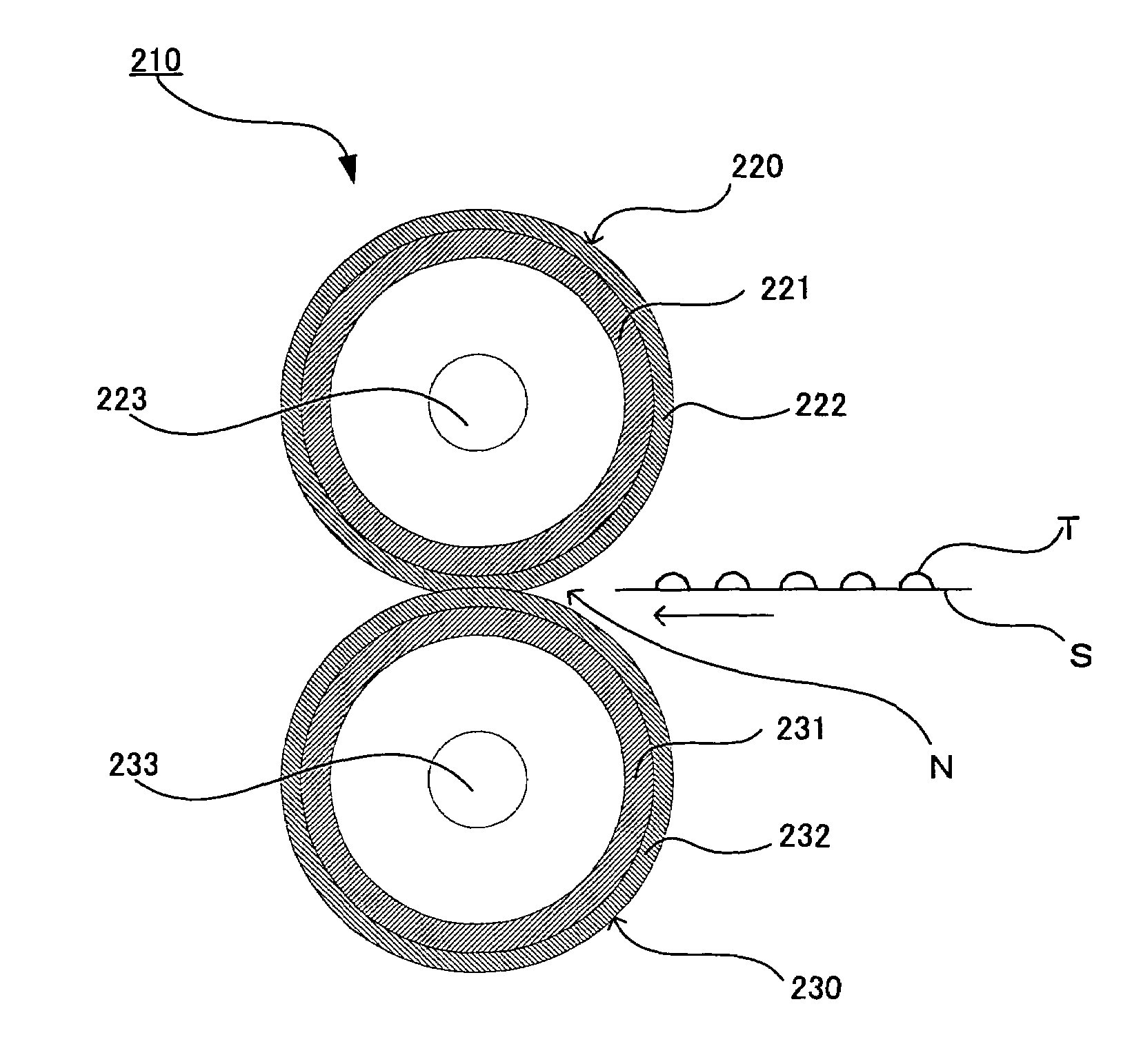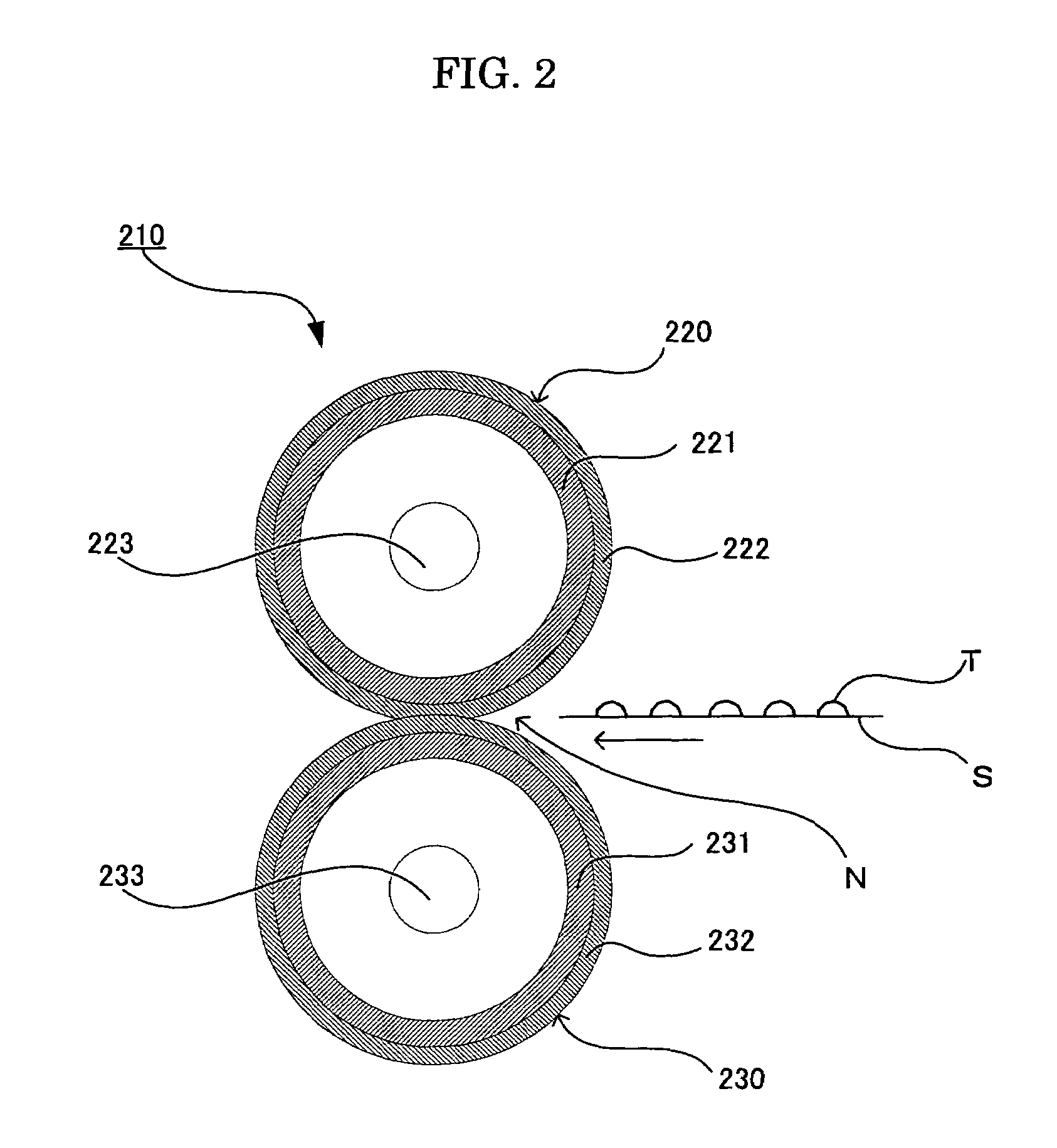Image-fixing method and image-fixing device, and, image-forming method and image-forming apparatus
a technology of fixing device and fixing method, which is applied in the direction of electrographic process, electrographic process using charge pattern, instruments, etc., can solve the problems of increasing the thermal capacity of the heating roller, affecting the quality of the image, so as to prevent the occurrence of off-set, improve the glossiness, and improve the effect of quality
- Summary
- Abstract
- Description
- Claims
- Application Information
AI Technical Summary
Benefits of technology
Problems solved by technology
Method used
Image
Examples
production example 1
[0408]A toner was prepared in a manner as described hereinafter.
-Preparation of Toner Solution-
-Preparation of Unmodified (Lower Molecular Mass) Polyester-
[0409]Into a reactor equipped with a condenser, a stirrer, and a nitrogen gas feed tube were poured 220 parts of ethylene oxide (2 mole) adduct of bisphenol A, 561 parts of propylene oxide (3 mole) adduct of bisphenol A, 218 parts of terephthalic acid, 46 parts of adipic acid, and 2 parts of dibutyltin oxide. The mixture was reacted at 230° C. at normal atmospheric pressure for 8 hours and was further reacted at a reduced pressure of 10 mmHg to 15 mmHg for 5 hours. Thereafter, the reaction mixture was further reacted with 45 parts of trimellitic anhydride at 180° C. at normal atmospheric pressure for 2 hours, thereby yielded unmodified polyester. The unmodified polyester had a number-average molecular mass (Mn) of 2,500, a mass-average molecular mass (Mw) of 6,700, a glass transition temperature (Tg) of 43° C., and an acid value o...
production examples 2-7
-Preparation of Toner-Base Particles-
[0444]The toner-base particles of Production Examples 2-7 were obtained in a manner as described in Production Example 1, provided that the amount of the carnauba wax, the amount of the vinyl-modified polymer, the wax content and the intensity ratio (P2850 / P828) of the wax were changed as shown in Table 1.
-External-Additive Mixing-
[0445]The thus obtained toner-base particles of Production Examples 2-7 were added with the external additives in a manner as described in Production Example 1, thereby yielded a toner of Examples 2-7. The thus obtained toner of Examples 2-7 was evaluated in a manner as described in Production Example 1. The results are shown in Tables 1 and 2.
[0446]
TABLE 2VolumeNumberaverageaverageSizeTonerAveragediameterdiameterdistributionNo.circularityDv (μm)Dn (μm)Dv / Dn10.9635.54.91.1320.9575.85.21.1230.9625.75.01.1440.9645.65.11.1050.9555.45.01.0860.9615.34.81.1070.9565.75.21.12
[0447]The present invention is illustrated in details...
example 1
[0448]A toner image was formed, and fixed onto a recording medium as follow, by using the developer obtained by Preparation Example 1. The obtained image was then evaluated in terms of: (a) fixing properties (lowest fixing temperature, and highest fixing temperature for inhibiting offset), (b) glossiness, (c) image density, and (d) a presence of a recording medium wrapping around the fixing members.
[0449]The results summarized in Table 2.
[0450]Toner image were formed so as that the maximum toner deposition amounts are respectively to be 0.4 mg / cm2, 1.0 mg / cm2, 1.5 mg / cm2, and fixed onto recording mediums by means of an image forming apparatus equipped with the belt-fixing device 110 illustrated in FIG. 1.
[0451]In the belt-fixing device 110, fixing was carried out by means of a fixing roller 122 and a fixing belt 123 which function as the image-contact fixing member, a pressurizing roller 124 which functions as the no-image-contact fixing member, and a heating roller 121, at conditio...
PUM
| Property | Measurement | Unit |
|---|---|---|
| volume average particle diameter | aaaaa | aaaaa |
| depth | aaaaa | aaaaa |
| temperature | aaaaa | aaaaa |
Abstract
Description
Claims
Application Information
 Login to View More
Login to View More - R&D
- Intellectual Property
- Life Sciences
- Materials
- Tech Scout
- Unparalleled Data Quality
- Higher Quality Content
- 60% Fewer Hallucinations
Browse by: Latest US Patents, China's latest patents, Technical Efficacy Thesaurus, Application Domain, Technology Topic, Popular Technical Reports.
© 2025 PatSnap. All rights reserved.Legal|Privacy policy|Modern Slavery Act Transparency Statement|Sitemap|About US| Contact US: help@patsnap.com



